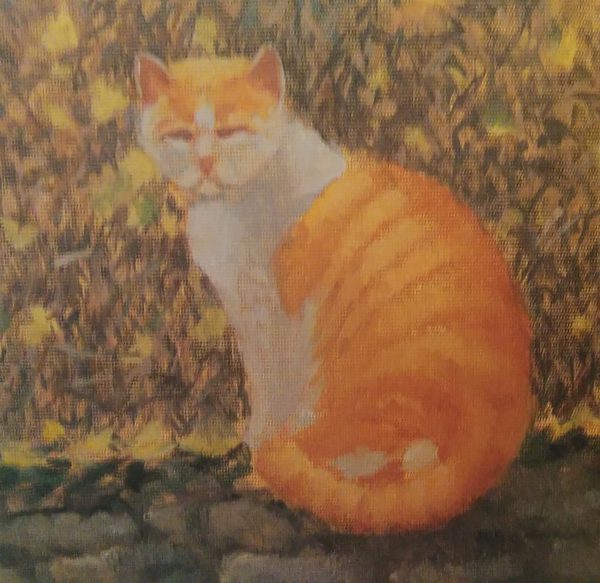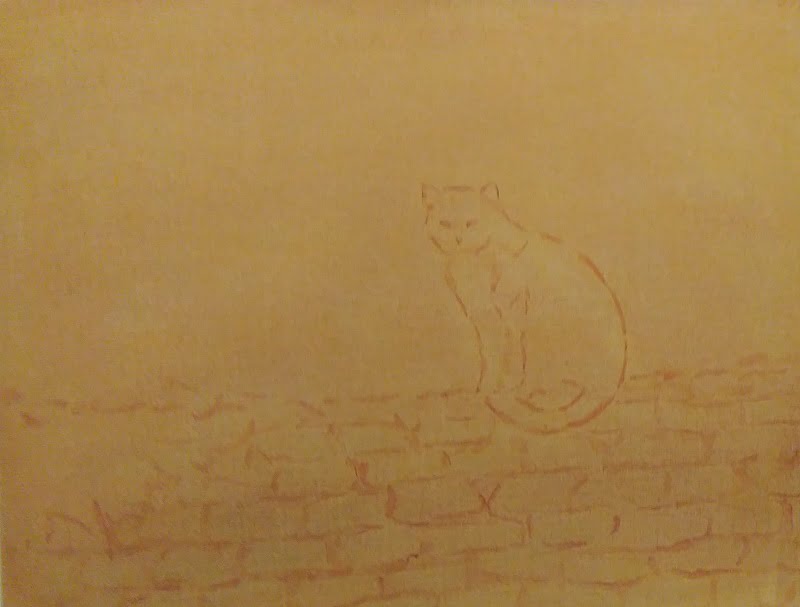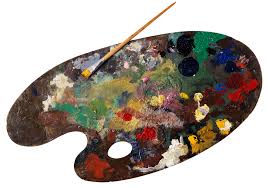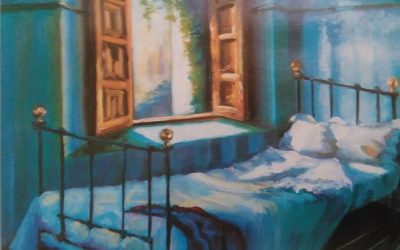A good way to achieve harmony in your painting is to concentrate on a small palette of paints and paint with analogous colors. Analogous colors are any three colors that lay next to each other on the color wheel. Those colors are in harmony with each other because they share the same primary color.
Nature provides us with many good examples for painting with analogous colors. Just think of the colors of the autumn landscape and all the gold, red and yellow. Delicate shades of blue and green colors on water surfaces or colors of the sky at sunset.
There is a risk that too much harmony can appear somewhat dull and uninteresting so it is best that you add some contrast colors into the composition. One of the ways to get a vivid lively looking composition is using a limited palette of colors.
Painting with a limited palette is an excellent way for you to learn how to mix color properly. You will be amazed by how many nuances and colors you can get using just a few colors. Always try working on the entire painting simultaneously adding the paint from your brush on many different areas of the painting. When you paint in this manner repeating several colors throughout your painting it is inevitable that they come to natural harmony.

Cat On A Stone Wall
For this painting, you will need the following tools and mediums:
- Primmed canvas
- Round sable bristle brush number 6
- Round hog bristle brush number 8
- Refined linseed oil
- Odourless mineral spirits
- Wide brush (38mm)
You will also need the following paints:
Ochre Yellow, Burnt Sienna, Cadmium Red, Titanium White, Prussian Blue, Cobalt Blue, Lemon Yellow, Cadmium Yellow and Sky Blue.
Tone the canvas with ochre yellow diluted with mineral spirits. Add the paint using 38mm brush. Before the canvas is fully dry rub it with a clean cloth to make the paint a bit lighter and remove all visible brush strokes.
Leave the paint to dry ower night. Now you have a warm gold surface to paint on. While you paint you will leave the surface uncovered here and there and that will help you connect the colors on the painting and achieve harmony.

Sketching
Sketch the main contour of the cat and the stone wall. Paint using Burnt Sienna diluted with mineral spirits. Use round sable brush number 6.
Add stripes on the cat’s fur with Burnt Sienna then cover the shades on cats face and chest using a pale mixture of Cadmium Red and Titanium White diluted with mineral spirits and linseed oil.
Start working on the leaves in the background using a mixture of Prussian Blue and Cadmium Red adding white for lighter tones.
Add the paint with relaxed moves leaving the bigger part
of the surface uncovered. Continue working on the leaves, building them and small twigs with random brush strokes. Use the mixture of Prussian Blue and Cadmium Red to paint the shadows on each rock in the wall and also the shadows of the ivy on the wall on the left side of the painting.

Adding Details
Using brush number 8 mix Titanium White with a little bit of Cobalt Blue and carefully paint the fur on the face and chest of the cat with short brush strokes.
Let the pinkish shadows from the toned surface peek through the white areas on the fur. Add more color to the stripes using the mixture of Ochre yellow and Cadmium Red.
Continue working on the background using the same colors as before. Change the direction of the brush strokes in order to depict the thickness of the leaves.
Build the shadows on the wall with relaxed brush strokes.
Paint should be heavily diluted at this phase of painting so the surface shows through it. Mix thicker paint using Ochre yellow, Cadmium Red and white to gain pale peach color.
Use that color to paint between the leaves and on the wall to create soft lighter areas. Add the color by tapping softly with the brush on the canvas.
Mix Lemon Yellow, Cobalt Blue and a bit of Ochre Yellow to gain green which you will use to paint the ivy on the wall.
For the leaves that are in the sunlight mix Cobalt Blue, Lemon Yellow and white to gain cold blue-green color.
To paint the shadows under the leaves use the mixture of Prussian Blue, Cadmium Red, Ochre Yellow and white.
Use it to paint the stone wall always allowing the toned surface to be seen here and there through the paint.
Continue working on the cat by adding more mixture of Cobalt Blue and white for the fur on the face and chest.
For fur between the ears use Lemon Yellow and white with a bit of Cadmium Red. Eyes and nose of the cat cover with dark pink made of white and Cadmium Red with just little bit of Prussian Blue added.
In order to paint orange stripes use white, Cadmium Yellow and a bit of Burnt Sienna. Apply the paint with short moves to depict the soft fur.
Continue adding details on all the areas of the painting simultaneously never focusing on just one part of the painting.
Mix Lemon Yellow and white and add dots and smears on the painting here and there. With the same color additionally work on the ivy along the wall.


Finishing Touches
Create a thick mixture of Cobalt Blue and Lemon Yellow to get saturated green which you will use to work on the leaves creating a strong pattern of color and tone.
With a mixture of white and Cobalt Blue paint little areas of sky peeking through the leaves in the top part of the painting.
Using the same mixture paint the lighter tones on the stone wall with round hog bristle brush number 8.
Develop a rough texture on the wall with short vertical brushstrokes of thicker paint. In order to create dark grey for the shadows between some of the stone blocks
mix Cadmium Red and Prussian blue and then ad a little bit of Ochre Yellow and White to the mixture to soften the tone. It is important not to let the wall dominate the painting the focus should be on the cat not on the background.
Ad some Cadmium yellow on the cats face for lighter areas. Paint the ears with the mixture of Cadmium Red, Burnt Sienna and white then paint the edge of the ears with pure white in order to separate the cat from the background.
Point out the striped patterns on the cat with short moves of Cadmium Yellow mixed with white. Ad a little bit of Cadmium Red and Ochre Yellow to the mixture and paint the orange fur on the back and the tail with soft relaxed moves.
Use the mixture of Cadmium Red and Prussian Blue to ad deeper tones to the leaves in the background. Additionally work on the pieces of the sky using the mixture of Cobalt Blue and white.
Go back on the cat and ad a few smears of pure white across the fur on the neck and chest to make it look softer.
To ad details to the eyes of the cat use the mixture of Cadmium Red and Prussian Blue. Develop a spotted pattern of the stone wall with scattered moves using different mixtures of Ochre Yellow, white and a little bit of Cobalt Blue.
To finish the painting ad warmer, lighter areas on the wall using the mixture of Sky Blue, Cadmium Red and white. Point out the lightest areas on the ivy using Sky Blue, Lemon Yellow and white.
Repeat some of those colors on the leaves in the background to maintain the balance of colors. In the end, mix Cadmium red and white and paint a few pinkish twigs in the background.





Excellent article.